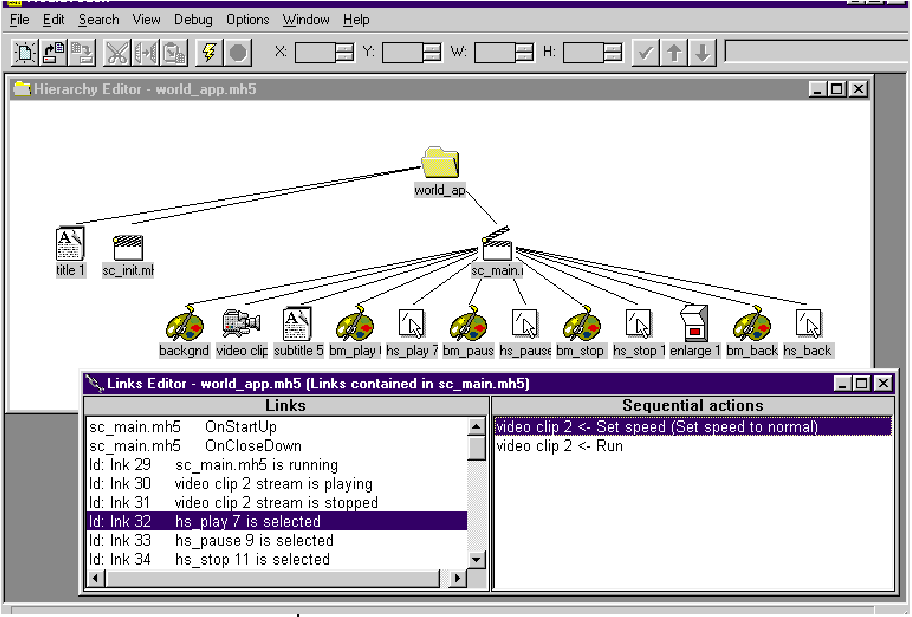
Armedia Client Architecture
Armedia is a client-server based interactive multimedia application
retrieval system.
- The client can be launched either as an autonomous Windows application or
- as a plug-in by an HTML browser, allowing seamless navigation between the World Wide Web and the webs of MHEG-5 applications. (See Armida system for more details).
The MHEG-5 RTE is the kernel of the client's architecture. It performs the pure interpretation of MHEG-5 objects and, as a platform-independent module, issues I/O and data access requests to other components that are optimized for the specific runtime platform.
The RTE performs two main tasks. First, it prepares the presentation and handles accessing, decoding, and managing MHEG-5 objects in their internal format. The second task is the actual presentation, which is based on an event loop where events trigger actions. These actions then become requests to the Presentation layer along with other actions that internally affect the engine.
- bulk download for bitmaps, text, and MHEG-5 objects; and
- progressive download for audio and audiovisual streams.
The implementation of these mechanisms occurs via the DSMCC interface. The user has full interactive control of the data presentation, including playback of higher quality MPEG-2 streams delivered through an ATM network. Object and content access requests can also be issued to the Web via HTTP. However, this wide-spread protocol still suffers from limitations when high-quality video clips are progressively down-loaded, since the underlying networks may not yet provide adequate quality-of-service (QoS). When accessing the broadcast service, the Access module requires the DVB channel selection component to select the program referred to by a Stream object. To achieve this, you set the Con-tentHook to a value that means Switched DVB and the OriginalContent to the identifier of the channel to select. The MPEG-2 stream transport-ed by the selected channel is displayed in the active Scene's presentation space.
The availability of an adequate authoring tool
is mandatory to create the MHEG applications.
The MediaTouch (Figure 8.15) application is one example
developed for the Armida Sysytem
(http://drogo.cselt.stet.it/ufv
/ArmidaIS/home_en.htm
).
It is a visual-based Hierarchical Iconic authoring tool, similar to
Authorware in many approaches.

MediaTouch MHEG Authoring Tool (Hierarchy and Links Editor windows)
MediaTouch is based on the native approach, which lets the author operate at the level of MHEG-5 objects.MediaTouch provides authors with the following functions:
- Hierarchy Editor
- -- Supports the interactive creation of the structure of Applications and Scenes objects. The author operates by adding, moving, and deleting Ingredients on the tree that represents the hierarchy's current status. Several Scenes from different Applications can be edited at one time and you can copy and move Ingredients between Scenes and Applications.
- Properties Editor
- -- The author sets the properties of Presentable Ingredients via an input form that is specific to each object class. The author does not need to type a value directly, since the system adopts a menu-based input interface that aims to minimize errors and inconsistencies.
- Layout Editor
- -- A Scene's layout can be set by interactively adjusting the position and size of the bounding box for every Visible Ingredient. An Ingredient's content data, when available, is also displayed within its bounding box to make the layout match the actual presentation.
- Links Editor
- -- This function lets authors add, modify, and delete links and actions to Application and Scene objects. The author sets the link conditions, actions, and referenced objects via a menu. Links and actions can also be copied between different scenes and applications.
Figure 8.15) shows a screen shot from MediaTouch where an Application composed of two Scenes and one shared Text is open within the Hierarchy Editor window. One of these Scenes shows its Presentable Ingredients, and the author is editing its Links. The author can then launch the RTE from within MediaTouch to check the outcome of his work.
The Current Release is 1.4 which performs the following:
- Director 6.5 to MHEG-5
- Available on both Macintosh and Windows 95/NT platforms
- Advanced dynamic lists support, new Converter Xtra settings (text data exported as external data...), converted applications optimisation, and more.
- MHEGPlayer is an MHEG-5 interpreter which is able to execute
MHEG-5
applications developed with MHEGDitorTM or any other authoring tool. It
implements the MHEG-5 International Standard according to the additional
requirements of the DAVIC application domain. The available content types are
aligned with the underlying operating system.
MHEGPlayer consists of a core interpreter with presentation system for Windows
95/NT. It is pre-configured to utilise the local file system to access MHEG objects
and content data.
Supported Formats include:
- Bitmap: PNG, BMP, TIFF, JPEG, PSD
- Video: MPEG-1, AVI, Quicktime (via MCI)
- Audio: Wave, AIFF_C (via MCI)
- MHEG-5: ASN.1 (DER) or Textual Notation
- MHEG Java Engine -- Java Source code exists to compile a platform-independent MHEG player ( http://enterprise.prz.tu-berlin.de/imw/)
- MHEG plug-ins for Netscape Browsers and Internet Explorer have been developed,